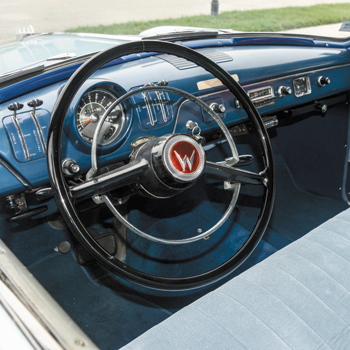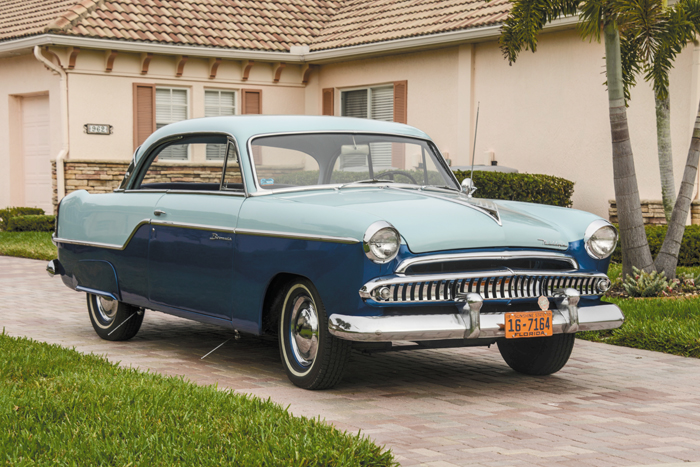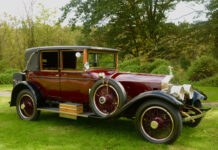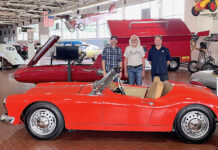By Jay Hirsch
The name Willys may not be that familiar to many people today, but the name Jeep certainly is. The original Jeep was made by Willys Overland, a car company going back to 1908 when John Willys bought the Overland Automotive Division of the Standard Wheel Company. From 1912 to 1918, Willys was the second largest car company in the United States, Ford being number one. The economic depression of the 1930s hit Willys hard, as it did all car companies.
In 1937 Willys designed a four-cylinder engine that in the not-too-distant-future would turn out to be the savior of Willys Overland Motors. The United States War Department was looking for an automobile company that could make a lightweight truck based on a design by the American Bantam Company. The design of a General Purpose vehicle would become known as the “Jeep.”
With the Japanese attack on Pearl Harbor, Dec. 7, 1941, and the Unites States’ entry into WWII, the Jeep became the backbone of the U.S. military. Not only did Willys produce Jeeps, but Ford and American Bantam did also. By the end of WWII Willys had produced 359,851 Jeeps and also created a cult-like following among all the members of the military who cherished these industructable, can-do-anything-go-anywhere, economical vehicles,
The word “Jeep”” was not an official name for the General Purpose vehicle. There are several stories as how the name came about. The one that seems to be the most popular is that G.I.’s shorted General Purpose to G.P. and pronounced it Jeep. In any event, Willys had the foresight to trademark the word Jeep, and the name has endured ever since.
Willys entered the civilian auto market in 1947 with the Jeepster, a two-door utility wagon, a pick-up truck with two and four-wheel drive, and the venerable JEEP. In 1952 Willys re-entered the car market with a new, smaller car, the Willys Aero. It came as a two-door sedan, a four-door sedan and a two-door hardtop named the Eagle. In 1953 Kaiser Motors bought Willys-Overland and changed the name to Willys Motor Company.
In 1955 the Aero Eagle name was changed to Bermuda. The Bermuda seen here is about 60 percent original. The trunk and rear passenger quarter were repainted in 2015. The seats had new material installed in 2013. The material and color go along with the 1950s theme but are not factory correct. The car has 81,000 original miles, which is documented. It was used infrequently when bought new by a couple in Connecticut as a “Sunday driver.” The owners had a flower shop in town and used a 1952 Chevy panel wagon for deliveries and going back and forth to work from their home, six days a week.
Their son, who sold the car in 2014, said his parents liked the Bermuda not only for the size of the car and the small engine for fuel economy but also the design with the Cadlllac-like talllights in the slight fin, the rear fender skirts and the two-door hardtop style.
“They always thought they were riding in a baby Cadillac, people even commented and asked if it was a small Cadillac,” the son told Howard Mints. The front bumper even has two small Cadillac-like, Dagmar projectiles.
The 1955 Willys Bermuda differed from the 1954 Willys in body trim. Where the 1954s side molding was straight from front to rear, the 1955 side molding had a “dip” of about five inches with the molding then going to the bottom of the rear tail light housing.
In 2014 the s on decided it was time for someone else to be the caretaker of the car. It had been stored in the heated garage of his house since 1982. He started the car a few times each year and driven it a few miles each time. Since his children no longer wanted the Bermuda, it was time for it to go to a new home.
on decided it was time for someone else to be the caretaker of the car. It had been stored in the heated garage of his house since 1982. He started the car a few times each year and driven it a few miles each time. Since his children no longer wanted the Bermuda, it was time for it to go to a new home.
Howard, the current owner, always liked “the car that is different…with style, whatever that is.” Among the cars Howard owns are a 1953 Nash Greenbrier, a 1955 Nash Ambassador and a 2005 Ford GT.
“When was the last time you saw a 1955 Willys Bermuda? You can see eight or more 1955–57 Chevy’s at a local show, but a 1955 Willys Bermuda? Never” Howard said.
Howard is also familiar with the six-cylinder super hurricane engine in the Willys.
“It is just a durable engine, a no-none-sense engine which is simple to work on” he said.
Howard was looking for a 1955 Willys after seeing one at a local car event in September 2012. He had looked at a few, but either they needed too much work or the owner was asking too much money. In the fall of 2014, a friend of Howard’s told him that a 1955 Willys Bermuda was listed at an auction he was going to attend. The auction was for cars not more than 15 years old with some being “exotics or supercars,” not really an auction one would expect to see a 1955 Willys.
Howard told his friend “Hoss” how much he was prepared to pay, if the car looked all right to Hoss — and obviously it did, for two weeks later it was in Howard’s garage. For the next two months, Howard and Hoss went through the car, replacing the brake hoses, brake shoes, rebuilding the carburetor, and doing basic maintenance that should be done to any car that basically was not driven for over 33 years. Starting a car a few times a year is not the same as driving a car at least once a month for an hour or more.
As for the ride, with the car’s radial tires and compact size the car corners more like a compact car of the 1980s. The ride is firm and smooth with ample leg and headroom. With a height of 60 inches, there is no need to duck to enter the Bermuda. The seats are high and your legs “hang down,” they are not stretched out flat as in many new cars. Sitting in the Bermuda is more like sitting in a club-like chair in a den or living room. The ample glass makes for almost 360-degree visibility with no blind spots. The short hood makes for an excellent view of the road.
When people see the car the first question they ask is “What is it?” After explaining the Jeep connection, people have a better understanding. The size of the car is what seems to throw most people who are not “car people.” It is not what they thought of as a 1950s American cruiser.
In 1970 Kaiser Jeep was sold to American Motors when Kaiser Industries decided to leave the automobile business. Chrysler bought AMC in 1986 with the sole purpose of making and selling the popular Jeep. In 1998 Mercedes acquired an interest in Chrysler which eventually did not turn out well for Mercedes or Chrysler. In 2009 Fiat bought 53 percent of Chrysler, which still makes and sells the Jeep
The year 1955 was the last that the Willys automobile was made in the United States. The car was made in Brazil into the 1960s. •



